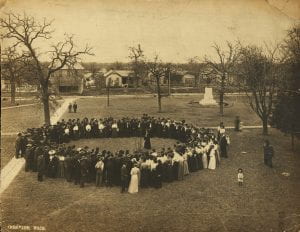This blog post was written by second-year Student Assistant Brigid Splaine. Brigid recently completed her Junior year as a Political Science Major, with a Minor in History.

Despite these ongoing inequality issues, Baylor was able to effectively address them with the help of the American Association of University Women (AAUW). Established in Boston, Massachusetts in 1882 as the American Association of Collegiate Alumnae (AACA), this group focused on inequality issues by developing higher educational opportunities for women while also setting high standards for institutions serving women. In 1921, the AACA merged with another group, the Southern Association of College Women, to form the AAUW we can still see working today. The AAUW began its involvement at Baylor in 1923, when it recognized the university as being one of the few in the state of Texas to be placed on this accredited list (1). The AAUW would accredit higher education institutions after they displayed that a fixed set of standards had been met by the university, such as providing the “same pay for the same work as men” and calling for a dean of women to be created that would have “an equal rank with that of the dean of men” (1).
Ms. Edna E. McDaniel arrived in Waco in the fall of 1924 to serve in the newly created role as Dean of Women at Baylor University (2). Previously serving at the University of Texas in the same role, Ms. McDaniel was influential in helping Baylor obtain admission into the American Association of University Women as well as improving the lives of female students at the university. After her arrival in the fall of 1924, the new Dean of Women helped Baylor achieve the standard for accreditation and earned “admission into the AAUW” (2). McDaniel “advocated strongly for the vocational opportunities” for female students on campus, wanting Baylor women to be “well rounded and seek out vocations they were passionate about” (4). Dean McDaniel helped break down the barriers of the “women’s sphere” on campus by encouraging women to pursue careers outside of the socially acceptable teaching degree. She states that it was “a pity that there are so many women with various talents who are all trying to be schoolteachers when they finish their college career” and while she saw the teaching professions as a noble line of work, she believed “there are a large number of other fields in which some women would be far more successful than they would be in teaching” (3). When Dean McDaniel resigned from her position at Baylor in the Spring of 1926 to “accept a position with the University of Oklahoma as dean of women” her impact was profoundly felt across the Baylor campus for years to come (2). From 1921 to 1930, the percentage of women enrolled at Baylor increased 5%, no doubt because of the improved conditions for female students cultivated by the work of Dean McDaniel and the American Association of University Women (6).
The AAUW chartered its Waco branch in 1926. The Waco Branch continued to carry out the AAUW’s mission of promoting education and equity for women through a variety of different programs including everything from study groups to science fairs to scholarship programs. The Waco Branch worked to support college-educated women at Baylor, as well as middle-school aged girls in the community in any way they could. After 75 years of serving Baylor and the surrounding community, the Waco Chapter of the AAUW disbanded in 2001 due to declining membership numbers and insufficient funds, but the legacy of their work would continue to be felt for many years to come.
Works Cited
- “For Equal Rights in Coed Colleges: Texas Branch of American Association of University Women will Demand Justice” Waco News-Tribune, 27 April 1926, https://newscomwc.newspapers.com/image/85054460/?terms=American%20Association%20of%20University%20Women&match=1
- “Dean of Women at Baylor Drafter by Oklahoma to Take New Place in Fall” Waco News-Tribune , 22 April 1926, https://newscomwc.newspapers.com/image/85053624/?terms=%22American%20Association%20of%20University%20Women%22&match=1
- “Decades of Growth: 1919 – 1940s” Impact, School of Education, Baylor University https://www.baylor.edu/soe/impact/news.php?action=story&story=215394
- DeLong, Misha. “Road to Educational Equality: Women’s Access at Baylor from 1921 – 1930.” HESA Baylor History Project, https://blogs.baylor.edu/hesabaylorhistoryproject/mishas-paper/
- “Meet Seven Baylor Women who Blazed New Trails in the Sciences.” BaylorProud, 7 March 2019, https://www2.baylor.edu/baylorproud/2019/03/meet-7-baylor-women-who-blazed-new-trails-in-the-sciences/#:~:text=It%20began%20with%20Mary%20Gentry,parts%20in%20the%20university’s%20success.
- “Access at Baylor: 1921 – 1930.” HESA Baylor History Project, https://blogs.baylor.edu/hesabaylorhistoryproject/baylor-1921-1930-2/access-at-baylor-1921-1930/


















